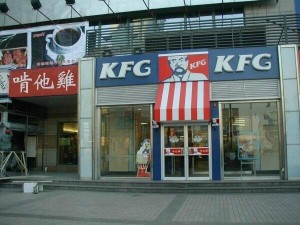Nibble His Chicken
« previous post | next post »
If you were a foreigner walking down the street in a Chinese city and you passed the restaurant below, you would do a double-take, because the familiar KFC has morphed into KFG, and Colonel Sanders doesn't look quite right. But if you were a Chinese walking down the street and passed by the same restaurant, you would do a triple-take, because the familiar 肯德基 (KEN3 ["consent; agree; be willing"]DE2 ["virtue"]JI1["foundation; base"]), which is simply a phonetic transcription of "Kentucky," has become 啃他雞 (KEN3 ["nibble; gnaw"] TA1 ["he, him, his"] JI1 ["chicken"]), with a blatant double entendre on the last syllable (referring to the male of the species).
(Click the image to enlarge.)
This obvious infringement of a famous brand is merely one instance of a very widespread phenomenon in China, numerous examples of which are documented here.
Such linguistic machinations and design manipulations are altogether different from the Chinglish gaffes that we have studied from time to time on LL. Whereas the latter are inadvertent, this type of trademark piracy is entirely intentional. Sometimes the piracy is done crudely, sometimes cleverly. Often the results are hilarious, and it is surprising how frequently the fake brand names are vulgar, such as when "White Cat [Detergent]" (BAI2MAO1 白猫) is transformed into "F*ck Cat [Detergent]" (RI4MAO1 日猫). The use of RI4 日 ("sun") to express a slang term that I have heard on countless occasions in Sichuan is a good example of how seemingly innocent characters can be utilized for the filthiest swear words. Before long, I shall write about the rather amazing applications of NIU2 牛. For the present moment, I'll simply close by mentioning that the proliferation of knockoffs and ripoffs in China is commonly attributed to SHAN1ZHAI4 山寨 ("mountain stronghold / fortress") entrepreneurs, SHAN1ZHAI4 referring to the lairs of bandits who are outside the law.
Thanks to David Hu for introducing me to chinaSMACK.

Coby Lubliner said,
November 5, 2008 @ 9:20 pm
In the 1970s, probably before McDonald's had spread to Colombia, there was a hamburger joint in Bogotá called McDonnell's, with a single arch on its sign.
Micah said,
November 5, 2008 @ 11:09 pm
I noticed that you used an avoidance character in the English, F*uck cat, but not in the Chinese, ri mao. Of course, you needed to print it to demonstrate the way that a stroke was eliminated from bai to cleverly form an expletive, but it got me to wondering how such matters (avoiding a full expletive but leaving sufficient residual evidence) are dealt with in Chinese.
John Cowan said,
November 6, 2008 @ 12:47 am
"Why has the Western barbarian no chicken?" –Koans Ancient and Modern
AlexM said,
November 6, 2008 @ 7:24 am
On a related note, I have long wondered how website addresses are pronounced in Chinese. For example, how would http://www.kfc.com be spoken in a radio advertisement? Are there any conventions for pronouncing latin letters ?
Zubon said,
November 6, 2008 @ 9:22 am
I am also curious about Chinese expletive avoidance.
I recall that Japanese writing sometimes uses "X" as a generic character in the sense of how Charlie Brown's parents talk (not avoidance). My English-speaking Japanese-language class was somewhat confused when the cartoon in the text showed a shopkeeper under the sign "XXX," merrily selling his wares for the example sentences.
Dougal Stanton said,
November 6, 2008 @ 12:00 pm
Someone recently went to a lot of effort to surreptitiously rebrand the Greggs bakers near where I live, using professionally printed stickers with the correct livery but the name Dreggs and some biohazard symbols. It didn't last long but it certainly gave me a laugh.
Micah said,
November 6, 2008 @ 5:05 pm
AlexM, They use the English names for the Latin alphabet to various degrees of accuracy, but most Chinese, even if they don't know a word of English can pronounce the letters well enough to be understood by an English speaker. They use the British name for "z", that is "zed".
Troy S. said,
November 7, 2008 @ 7:53 am
This reminds me of a fried chicken joint a Jamaican friend of mine once told me about on the island advertising "sudden fried chicken." Not exactly trademark infringement, but apparently a corruption of "southern fried
chicken." I'm not sure how appetizing flash-fried poultry sounds, but at least the service should be quick.
Kevin Iga said,
November 7, 2008 @ 12:06 pm
Question: Was this in Hong Kong? I see they are using the traditional character for chicken, rather than the simplified one, which would exclude mainland China. If so, I wonder if there's a relationship between 雞 and the "G" in "KFG": in Cantonese, this character is pronounced "gaai1" rather than "ji1".
Lucas said,
November 10, 2008 @ 4:07 am
It looks to me that the KFG image has been doctored (Photoshopped)–and quite poorly.
Aaron Davies said,
November 12, 2008 @ 6:49 pm
I am reminded vaguely of Saturday Night Live's Pete Schwetty, purveyor of Christmas party food, sold, of course, under the name "Schwetty Balls".
Randy Alexander said,
November 15, 2008 @ 10:46 am
I always wondered why they didn't name it (I mean the real one) 啃得鸡 (kěnde jī, gnawing chicken), since that's what you do there, and it still sounds as much like Kentucky.
spencer said,
November 16, 2008 @ 1:23 am
and PFK in montreal. (poulet!, mais oui)